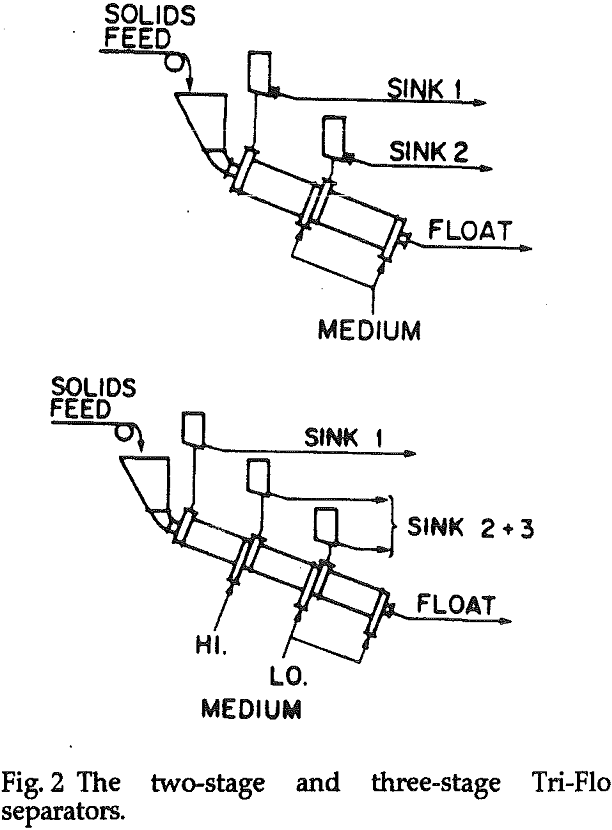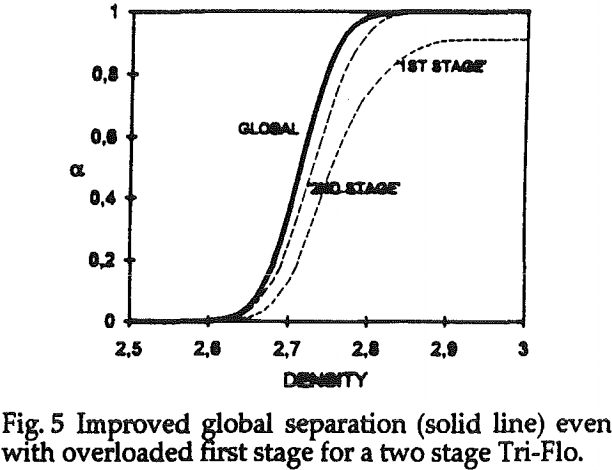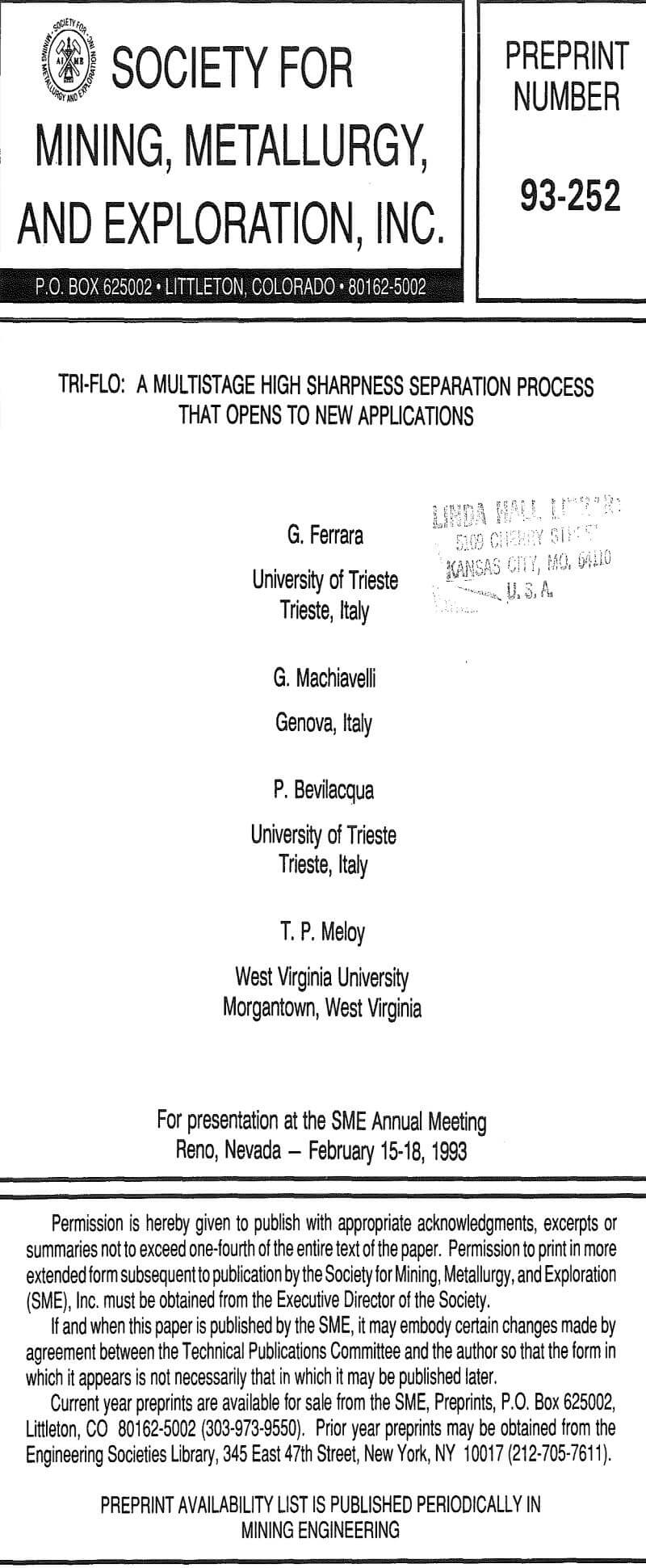Table of Contents
During several years of operation in Europe, South Africa and other countries, the Tri-Flo has demonstrated to represent a substantial improvement of the dense medium dynamic separation systems. The reasons are:
- high sharpness separation due to the multistage system and the application of new concepts m designing the regeneration circuit and controlling the medium rheology:
- the possibility of performing two cuts at different densities using a single separation device and a single regeneration circuit
The Multi-Stage Separation
Both multi-stage systems of rewashing the primary float and the primary sink have been proposed. So far, however, only the first system has been applied widely in industrial plants.
The improved efficiency currently obtained using this system is the consequence of two concurrent facts:
(a) the improvement inherent in rewashing the float products, which can be predicted by studying the modification of the partition curve;
(b) the improvement due to the fact that, after the bulk of the heavy material has been scalped off by the first stage, the following stages greatly benefit of more stable operating conditions.

In order to achieve this improvement the difference between the cut points of the stages is kept small and a common supply of medium is used for all the stages. The required small density difference follows naturally from the “dilution” of the second and third stages with the float media of the first and second stages, respectively.


When separate sink grades are required, for example in a two-stage separation, the gap between the two separations can be increased by raising the back pressure of stage 1, reducing the back pressure of stage 2 and, if necessary, reducing the stability of the medium.
Three separate products with a larger difference between the two cut points can be obtained by using two separate media. An interesting feature of considerable practical value of a two-stage separator is that, even with an abnormally poor performance of the first stage under overloaded conditions, this performance is corrected to a very large extent by the second stage so that a high global efficiency is maintained.

The importance of stable operating conditions in mineral processing operations, though sometime mentioned, has not always drawn enough attention. In particular, the worsening of the separation efficiency due to fluctuations in ore characteristics is either not considered or underestimated. For example, in dynamic DMS processes it is considered obvious that suitable control systems of the feed rate and medium properties (particularly medium density control) are necessary for obtaining stable operating conditions.
Therefore, fluctuation in ore characteristics – e.g. the grade in heavy minerals – results in fluctuation in the amount of sink product, and hence in a crowding effect at the apex of the cyclone which causes fluctuation in the underflow medium density in much a similar manner as is produced by decreasing the apex diameter.
The Multi-Density Separation
The multi-density separation is becoming very important for a number of problems concerning the processing of industrial minerals, metalliferous ores and coals. The following examples are reported:
(a) From barite ores it is possible to obtain a marketable concentrate (suitable for drilling purposes) by performing a high density cut in dynamic DMS systems. However, a significant proportion of BaSO4 may be lost in the float A higher BaSO4 recovery can be obtained by a second low density cut giving low grade tailings and middlings that can be ground and upgraded by flotation.
(b) Chromite ores can be treated by dynamic DMS performing a two-density separation: a high density cut for obtaining a high grade concentrate suitable for smelting, low grade tailings and middlings for further gravity separation by spirals and tables (Kitsicopoulos et al).
The medium circuit has to meet the following requirements:
- produce the medium streams at different densities whose values have to be stable at the required set-points;
- control the medium streams as concerns the composition of solids (proportion and size consist of ferrosilicon, magnetite and non-magnetic contaminant), in order to obtain proper medium viscosity and stability values for each density.
This circuit has a very stable behavior for the following reasons. While the mean density δm of the total medium depends on its total volume and on the specific gravity and total weight of the suspensoid, under steady-state conditions the densities δ1 and δ2 in the two sumps differ from δm (δ1 being higher, δ2 lower) depending on the position of the splitters. If during start-ups or because of occasional unsteady state conditions the densities in the two sumps δ1 and δ2 differ from δ1 and δ2 they will converge towards δ1 and δ2 rapidly, practically in 6-8 minutes. Therefore the circuit structurally behaves as a very stable one.
The final density control of the medium streams fed to the multi-stage separator, in its simplest form, is operated by on-line nuclear density meters, PI controllers and water addition valves through a classical feedback technique.
The Separating Medium
The density of the medium, its rheological behaviour (viscosity) and capacity to maintain the homogeneity (stability) during operations under high shear rates and acceleration conditions, such as those typical of dynamic dense media separation systems, are the factors that most influence the separation.
The density of the medium is related to the needed cut density and therefore is mainly responsible for the position of the density-partition curve (Tromp curve), while the viscosity and the stability mainly affect the shape (tails and Ep values) of the partition curve and, hence, the separation efficiency.
The three variables are interrelated and also depending on: particle shape and size consist of the magnetic and non-magnetic components of the solid constituting the medium, magnetization of magnetic components and density of the solid. The last one can be calculated from the density and proportion of the components, i.e. magnetic components (magnetite and/or ferrosilicon) and non-magnetic contaminant coming from the ore.
The feed material consists of a coarse fraction, which does not interfere with the medium circuit and produces a heavy fraction (sink), and a light fraction (float) indicated in the figure as “products”. In addition, there is a fine fraction passing through the draining screens of the products and entering the medium, as well as fines produced by abrasion or consequent to friable or water-degradable characteristics of the feed material.
Industrial Applications
Dynamic DMS multi-stage systems have found very wide industrial application for preconcentration or concentration of heavy minerals or for coal preparation and are in operation or under construction in a number of countries. Some important applications are mentioned in the following sections.
The first application was made at the Masua Mine, Sardinia, where two parallel preconcentration lines were present one was equipped with a two-stage separator (a Tri-Flo prototype) and the other with a single stage separator (DWP).
The mean results of a 10-week operation for the same ore indicated that the multi-stage system allowed an increase in the preconcentrate grade from 4.26% Pb and 6.31% Zn to 7.89% Pb and 10.88% Zn; at the same time also the metal recovery was increased from 88.5% Pb and 75.5% Zn to 91.6% Pb and 76.5% Zn 23. These results were achieved in spite of the old design of the plant in particular the medium circuit and medium control system. The Ep values were of the order of 0.040-0.050 when treating the size class -12+0.5 mm.

